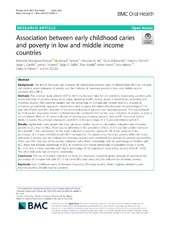Association between early childhood caries and poverty in low and middle income countries
Folayan, Morenike Oluwatoyin; El Tantawi, Maha; Aly, Nourhan M; Al-Batayneh, Ola B.; Schroth, Robert J.; Castillo, Jorge L.; Virtanen, Jorma; Gaffar, Balgis O.; Amalia, Rosa; Kemoli, Arthur; Vulkovic, Ana; Feldens, Carlos A.
Peer reviewed, Journal article
Published version

Åpne
Permanent lenke
https://hdl.handle.net/1956/23792Utgivelsesdato
2020-01-06Metadata
Vis full innførselSamlinger
Originalversjon
https://doi.org/10.1186/s12903-019-0997-9Sammendrag
Background: The aim of this study was to assess the relationship between early childhood caries (ECC) in 3–5-year-old children, seven indicators of poverty and the indicator of monetary poverty in low- and middle-income countries (LICs, MICs). Methods: This ecologic study utilized 2007 to 2017 country-level data for LICs and MICs. Explanatory variables were seven indicators of poverty namely food, water, sanitation, health, shelter, access to information, education; and monetary poverty. The outcome variable was the percentage of 3–5-year-old children with ECC. A series of univariate general linear regression models were used to assess the relationship between the percentage of 3–5 year-old children with ECC and each of the seven indicators of poverty, and monetary poverty. This was followed by multivariable regression models to determined the combined effect of the seven indicators of poverty, as well as the combined effect of the seven indicators of poverty and monetary poverty. Adjusted R2 measured models’ ability to explain the variation among LICs and MICs in the percentage of 3–5-year-old children with ECC. Results: Significantly more people had food, sanitation, shelter, access to information, education and monetary poverty in LICs than in MICs. There was no difference in the prevalence of ECC in 3–5-year-old children between LICs and MICs. The combination of the seven indicators of poverty explained 15% of the variation in the percentage of 3–5-year-old children with ECC compared to 1% explained by monetary poverty. When the seven indicators of poverty and the indicator for monetary poverty were combined, the amount of variation explained by them was 10%. Only two of the poverty indicators had a direct relationship with the percentage of children with ECC; there was a higher percentage of ECC in countries with higher percentage of population living in slums (B = 0.35) and in those countries with higher percentage of the population living below poverty lines (B = 0.19). The other indicators had an inverse relationship. Conclusion: The use of multiple indicators to measures of poverty explained greater amount of variation in the percentage of 3–5-year-olds with ECC in LICs and MICs than using only the indicator for monetary poverty.
